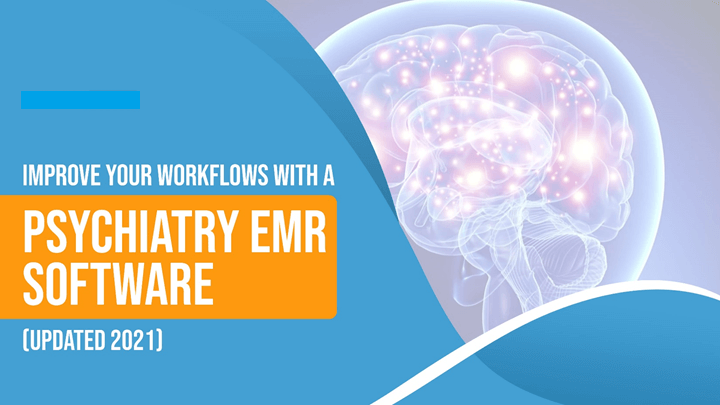
Imagine if someone told you that you could earn an additional $36,000 a year and take three weeks off each year without increasing the size of your patient portal or practice personnel.
The first question you’ll undoubtedly ask is, “How?” after you’ve gasped in awe. The answer’s simple, efficiency. You are wasting significant time with each patient visit if you are employing a manual record-keeping system that slows down your patient intake process. It will knock your socks off if we do some cold, hard math on how much time and money that extra effort is costing you.
Using psychiatry EMR software in your clinic can help you streamline your whole workflow and boost efficiency in a variety of ways. Here are the top five ways that psychiatric EMR software can help you run your practice more efficiently:
Reduce Redundancies
A Psychiatry EMR software allows you to cut redundancies, save time, and increase productivity. You might ask: How can I save time during patient visits? Certainly not by cutting down on face-to-face time with the patient!
Instead, why not spend less time in front of your EHR software? If you save 30 seconds on a few typical procedures by adopting Psychiatry EMR software with a streamlined workflow and user-friendly UI, you can quickly save your valuable time throughout every appointment.
In a multitude of settings, your EHR software is a valuable asset to your front office.
For example, if a patient wishes to make a follow-up appointment, the practitioner can easily do so on the record. There will be no mistake about when or why he or she needs to return in this manner.
Aside from that, your psychiatrist EMR software keeps everyone up to date on the status of each patient. This allows employees to maintain a smooth patient flow, making the entire operation incredibly fast and effective.
Follow-Up Scheduling
A Psychiatry EMR software program allows you to document whether or not the patient requires a follow-up visit. It also keeps track of how frequently they need to be seen during their therapy session. This enables practitioners to keep a tight eye on the entire process, making it smooth and efficient.
Easy Prescriptions (E-prescriptions)
Often, practitioners hand out manual prescriptions to patients, which are either misplaced among the stacks of paper or mistakenly discarded.
This makes retaining patient records difficult to preserve and retrieve during an emergency.
E-prescription allows doctors and practitioners to electronically write prescriptions using psychiatry EMR software. It is also linked to nearby pharmacies in order to offer patients the most up-to-date drugs.
Aside from making record-keeping easier, it allows practitioners to save time and resources by allowing them to prescribe medicine from any location with a simple tap on their devices.
Also, read Get your Covid Test Reports in 1 Day!
Use Speech Recognition
Speech recognition or voice technology has advanced to incredible heights with the advancement of modern technologies. Healthcare practitioners may generate thorough patient charts in under five minutes and follow-up visits in less than three minutes with the correct tailored speech recognition package and EHR configuration.
In fact, adopting dictation technologies alone has the potential to reduce the time spent on documentation of care by 30 minutes or more every day. Voice recognition was previously incapable of understanding medical terminology, making it unavailable to medical practitioners. However, in the last year, speech recognition and other technologies have come a long way toward resolving this issue.
Today, solutions that understand medical terminology and can be programmed to recognize your intonation based on a few basic questions are available. You may use psychiatric EMR software to not only dictate your notes but also to streamline your workflow using innovative features. These include the automation of repetitive operations as well as the ability to view photos, lab data, and flow sheets while dictating.
In less than five minutes, a level 3 office patient E/M note (CPT code 99213) can be easily completed by voice, according to practices that use high levels of voice recognition. It can usually take more than 15 minutes to type this exact 99213 note.
Make Use of Templates
Templates and macros are useful when they are properly used to improve the effectiveness and completeness of documentation. This can be shown especially when restricted to standardized terms, including findings from physical exams and ROS.
The abuse of templates, on the other hand, may result in cookie-cutting notes that everyone sounds and looks the same. In fact, if the clinical documents are audited, there may even be a legal problem. Furthermore, templates may not necessarily facilitate documentation of quality. This applies especially to more complex patients whose tales or records do not fit into the typical formats.
Using an EMR psychiatric system, you can design customized templates that support your practice’s specific needs. In this sense, EHR systems that restrict free text entries are critical to avoid.
Final Words
Here you go, guys! This article gives you a deep look into several ways that psychiatry EMR software might streamline your medical practice. It eliminate redundancies, makes it possible for practitioners to use templates effectively, employ voice recognition, simplify follow-up procedures and facilitate prescription through e-prescription.